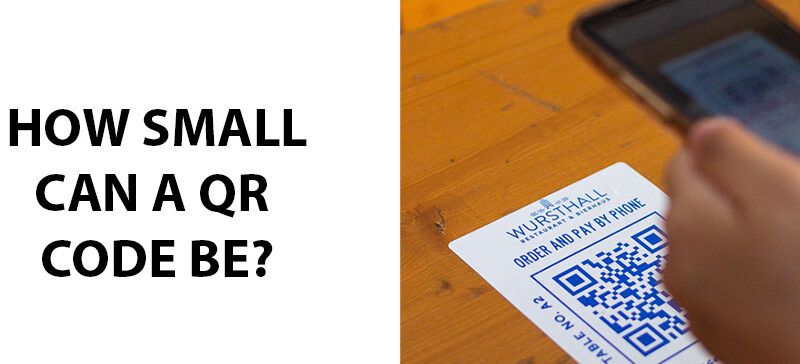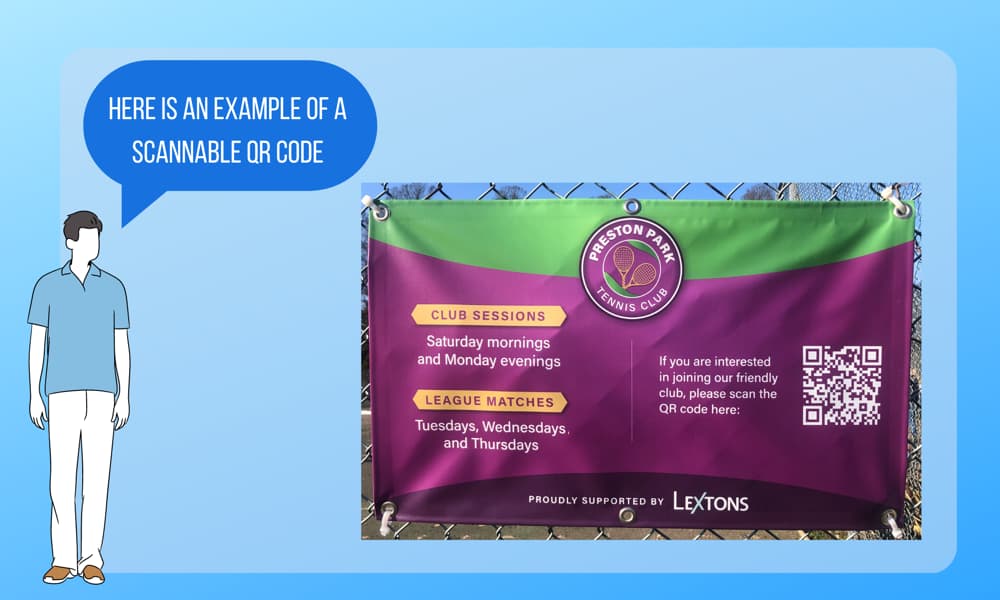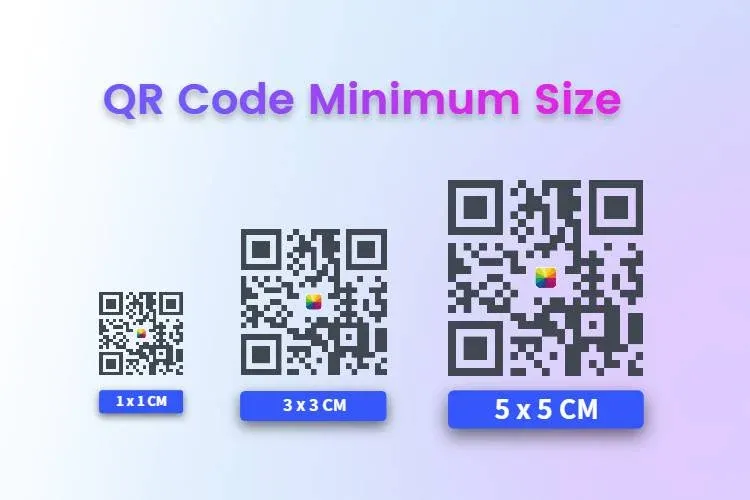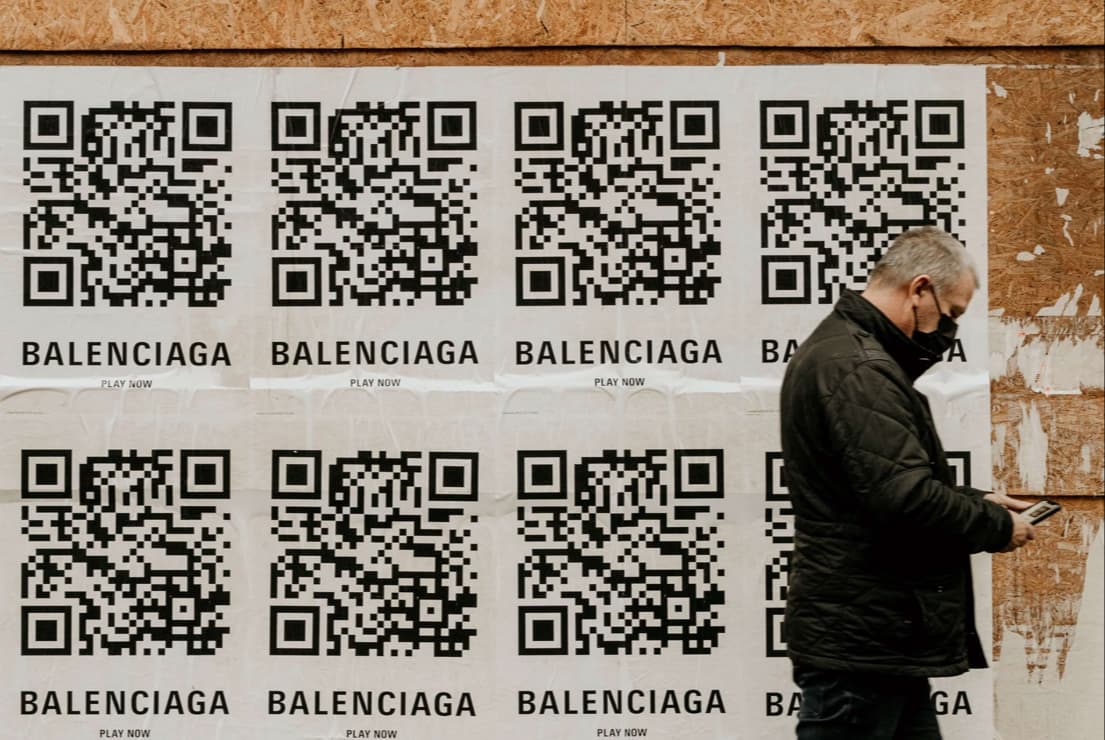
When it comes to QR codes, size matters. The size of your QR code can greatly impact its scannability, and ultimately, the success of your marketing campaign. But how small can a QR code be and still be scannable?
That's why we're diving into the nitty-gritty of QR code sizes. We'll explore the minimum sizes that still ensure scannability, and how to choose the right size for your specific needs. So, buckle up and get ready for a deep dive into the world of QR codes.
First, remember that scanability depends not only on the QR code size, but also the distance from which it'll be scanned. The further the scanning device is from the QR code, the larger the code needs to be. For instance, a QR code on a billboard 20 meters (65 feet) away should be roughly 2 meters (65 feet) across.

Here's a glimpse of long-distance QR code examples:
- QR codes on window stores
- QR codes on running vehicles
- QR codes on posters
- QR codes on billboards
Meanwhile, Calvin Klein leveraged this principle well, making QR codes on their billboard ads twice the usual size. They clearly understood one truth - the bigger your QR codes, the higher your chances of getting more scans and ultimately, a better conversion rate.
Let's delve a bit deeper, exploring the ideal minimum QR code size that'll offer the best results for your various needs. QRcode.co.uk provides qr code generation solution that fits united kingdom printing criterias.
Why you should care about minimum QR Code sizes?

When we get down to brass tacks, a QR code can become quite small. The minimum size recorded has been found to be 1 cm x 1 cm, translating to 10 mm x 10 mm, 0.4 inches x 0.4 inches, or 38 pixels x 38 pixels. But tapering a QR code down to this size isn't a walk in the park, it needs meticulous consideration of several elements. Just a few to name would be the error correction level, scanning distance, data capacity, and QR code type itself.
QR codes bring your products, items, or artwork to life; they offer a new digital perspective. It's crucial to adhere to this minimum size. When people spot it right off the bat, they'll be more likely to scan it without delay. Else, you're simply letting potential scans slip away. QR code size plays a pivotal role in this aspect.
Here's a knock-on effect you'd perhaps not given thought to - the amount of information you encode into your QR code. The more data you pack in, your dots will shrink in size. This phenomenon predominantly occurs when you're generating a static QR code. Tread lightly with the smallest QR code sizes. As these dots reduce in size, decoding them through a smartphone device can turn into a challenge.
If you find yourself with more data to encode, we advocate switching to dynamic QR codes. With this version, the codes won't get pixelated, and hence, become much easier to scan. Be warned not to expect the best results if you're using an inverted QR code color. A dark background with a light foreground is tough to identify for smartphone devices.
All these factors make keeping a keen eye on the QR Code minimum size not just smart, but necessary strategy. Quick response codes come in a myriad of shapes and styles, all unique in their own right. Pay attention to the details: the devil's always lurking there.
Does Size Matter For QR Code?

Indeed, size does matter when it comes to QR codes. Their purpose must be acknowledged and should be printed with care to preserve their scanability. Here, we'll elaborate on some crucial factors about QR Code sizes that are often overlooked.
How Big Should a QR Code be For Printing?
For QR codes to be recognized and decoded by a smartphone's reading application, they must be of adequate size, hence QR codes need to be larger than what's considered typical for print material. The minimum recommended size for a QR Code is 1x1 cm. Avoid printing them in sizes less than this as it can risk the readability of your QR Codes.
Nevertheless, QR code size isn't fixated and can be modified based on your usage scenarios. For instance, a QR code on a business card can be as small as 0.8 x 0.8 inches, sufficient for scans from short distances.
How Many Pixels is a Qr Code?
A QR code can store up to 4296 alphanumeric characters of arbitrary text. However, the pixel size plays a vital role as well. A QR code requires a minimum size of 2x2 cm, equal to roughly 76x76 pixels. If your QR code gets pixelated or blurred, mobile devices might find it challenging to scan.
What is The Smallest Qr Code Size?
The smallest QR code size, as mentioned earlier, is 1x1 cm, although this isn't generally used for commercial purposes. QR codes for commercial or personal use are typically between 3x3 cm and 5x5 cm. If your QR code is too small, mobile phone scanners may struggle to capture them effectively.
Do QR Codes Have to Be Square?
Yes. Because QR codes contain a fixed grid of data, they need to be square for proper scanning. Any deviation from this shape may result in scanning difficulties.
Can I Have a Circle QR Code?
While altering the shape of a QR code might seem like an innovative idea, it's discouraged. Retaining a QR code's original square shape is instrumental in ensuring it's scanability, so it's best to avoid circular or other shaped QR Codes.
How Much White Space Do You Need Around a QR Code?
The "quiet zone" encompassing the QR code, that isolates the QR Code's pixels from other designs, must be considered. Without this quiet zone, the QR code might not function. To ensure its readability, always print with high-quality images and put a focus on maintaining a substantial quiet zone for a successful scan from a distance.
Resolution requirements For QR Codes
A critical aspect to look into when creating a QR code is meeting the resolution requirements. These specifications ensure that the QR code perfectly retains its scanability regardless of the size. Remember, a QR code must remain square for optimal scanning; any deviation can hugely impact the scanability.
QR codes were designed for a 10:1 distance-to-size ratio. What's this mean? Simply, the most rewarding distance of a QR code scanner from a QR code should be 10 times the width of the QR code. To illustrate, if a QR code is 2 inches wide, the ideal scan would be a distance of 20 inches from it. Stick to this QR code distance-to-size ratio when working with any QR code.
Taking the resolution into account becomes increasingly vital when considering how big micro QR codes are. Given their already small size, any error will not just hinder scanning but may also lead to complete failure for it to be scanned.
When creating your QR code, ensure it has a minimum size of 2x2 cm (or roughly 76x76 pixels). This is important to prevent pixelation or blurriness which can obstruct easy scanning.
Equally important is the 'Quiet Zone' - the clear space enveloping the QR code. It's like a buffer that substantially separates the code from nearby elements and enables devices to precisely identify and scan it. The quiet zone's size is typically proportional to the QR code's dimensions. In essence, the bigger the QR code, the wider the quiet zone should be.
More individuals and businesses are integrating QR codes for contactless interactions, as confirmed by various QR code statistics. With this growing popularity, understanding and following QR code resolution requirements is absolutely essential to ensure that the QR codes we create are effective, reliable, and easy for everyone to scan.
A primer on QR Code specifications
Diving deeper into QR code specifications, the data capacity it is supposed to hold plays a significant role. The larger the volume of data within the code, the larger it needs to be. This aspect holds especially true for QR codes used in contactless payments, as these often contain encrypted details that need ample space to ensure both accuracy and security.
Beyond this, the printing technique and material also influence the size and readability of the QR code. Various printing methods might affect the clarity of the code. For instance, if the code is printed on a glossy surface, it might need to be larger to avoid glare and ensure precise scanning.
Influencing QR code size is its error correction level. Higher levels let the code stay readable even when partially obscured or damaged. However, accommodating these levels can demand larger sizes or increased resolution.
When considering a QR code's smallest viable size, we typically look at a micro QR code. This is the tiniest QR code a typical QR scanner, like a smartphone, can scan. While it is possible to print QR codes as small as 1x1 cm, it's safer to adhere to a minimum size of 2x2 cm to maintain a reliable scanning experience.
To bring this into perspective, for optimal use on business cards (which usually measure 3.5x2 inches or 9.5 cm), we recommend a QR code size of approximately 0.8x0.8 inches. Enlarging the code, in this case, can work but shrinking it isn't advisable as this could lead to the code becoming unscannable or simply too unnoticed.
In conclusion, optimal QR code specs depend on multiple factors including data capacity, printing technique, error correction levels, and intended use medium. Therefore creating "scan-friendly" QR codes requires a deeper understanding and careful consideration of these dynamics.
How big can a QR Code be?
Understanding how small your QR code can be is crucial, but considering the maximum size is just as significant. As QR code size directly impacts scanning efficiency and data storage, getting the maximum size right can make a world of difference.
In the world of QR codes, there's no set upper limit for size. Theoretically, your QR code could be as large as a billboard if you wanted. However, practicality should reign supreme here. Yes, a bigger QR code can store more data and have a farther scanning distance. But, it doesn't mean you should make them as big as possible. Consideration should be given to aesthetic appeal, integration within the environment, and cost-effectiveness.
An important detail we mustn't forget is the correlation between the size of a QR code and its scanning distance. Inspired by the universal 10:1 QR code distance-to-size ratio, it's safe to aim for a wider QR code if the expected scanning distance is increased. For example, if your QR code is 2 inches wide, scanning from a distance of 20 inches should pose no problem.
Using QR codes is now the norm in our increasingly contactless world. They've proven their value across a range of industries from restaurants and bars to retail stores. The reliability of QR codes directly influences their effectiveness, which puts even more emphasis on getting your QR code size right — maximum and minimum.
Lastly, let's not forget micro QR codes — a compact version of the standard QR code. Though smaller in size and data capacity, their specifications require careful consideration of their dimensions and usage scenarios. In the end, whether going big or small, it's crucial to understand these factors to create easily scannable and effective QR codes.
Determining QR Code size in relation to scanning distance
Getting the right size for QR codes is essential for successful scanning. While there's no one-size-fits-all solution, the scanning distance, the placement, and the color are key factors significantly influencing the QR code size.
Firstly, let's touch on scanning distance. You see, the size of your QR code and the scanning distance go hand in hand. At different distances, QR code dimensions need adjustment to remain scannable and visible. Opting for larger rather than smaller size helps ensure readability, even from extended distances. It's important to remember, as it directly relates to the exact square shape of the QR code.
But then, how big exactly should your QR code be to remain scannable even from afar? That depends on where you intend to place it. For instance, if you're looking at billboard advertising, then minimum QR code size will not cut it. It simply won't be visible enough from the distance most viewers will be at.
On the other hand, for printed marketing campaign materials such as catalogs or magazines, where the viewing distance is not as great, smaller QR code sizes may be appropriate. Determining the right size becomes a matter of aligning it with the location of your QR code and the medium you're using.
Additionally, we recommend printing at least three different sizes and comparing them to determine which one achieves your desired scanning radius. Should you need a wider scanning radius, plan for a bigger QR code.
Remember, using your QR codes effectively is a big deal. That means taking into account the distance that users will scan from, and thus, the size of your QR code.
Other optimizations while considering QR Code size
We've explored the intricate relationship between QR code size, scanning distance, and scan success. It's clear that QR code size isn't a one-size-fits-all situation. Factors like viewing distance, placement, and color all play a part. We've seen that larger QR codes work best for extended distances while smaller ones are ideal for closer viewing. But remember, it's not just about size. The effectiveness of your QR code also depends on its location and medium. So, don't forget to test different sizes and align your QR code size with its intended use. It's these small tweaks that can make a big difference in your QR code's success.
Frequently Asked Questions
1. How can I determine the appropriate size of a QR code?
You can determine the suitable size of a QR code based on the scanning distance. For longer scanning distances like billboard advertising, larger QR codes are necessary. Smaller code sizes are ideal for closer scanning from printed marketing materials.
2. What are the key factors affecting the size selection of QR codes?
The principal factors to consider are scanning distance, placement, and color. Testing various sizes helps you find the optimal scanning radius. Moreover, aligning the QR code size to the intended location and the medium can enhance effectiveness.
3. How do I create a QR code in the correct size?
To create a QR code, use an online generator. Input your URL into the generator and customize it, if the option is available. The generator will help you adjust the size based on your needs.
4. What is the size of a micro QR code?
Micro QR codes typically range from 11×11 to 17×17 modules. This size differs from standard QR codes, which range from 21×21 modules to 177×177 modules.
5. How durable are QR codes with regards to damage or missing parts?
QR codes are quite robust. Even if up to 30% of the QR code is damaged or unreadable, the information can still be retrieved.
6. What are general size specifications for QR codes?
The smallest QR code possible is 21 x 21 modules, and the largest can be up to 177 x 177 modules. Maximum data capacity for numeric encodings is 7089 characters, and for alphanumeric encodings, it's 4296 characters.
7. Is it possible to use Google to generate QR codes for free?
Yes, you can use Google to generate QR codes for free. There are also other online options available for free based on your specific needs.

